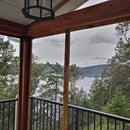Introduction: Copper Pipe Chandelier
This is one of a pair of chandeliers made from copper pipe, using LED candelabra bulbs. I wanted something that would suit a "great room" - a living room with high sloped ceilings - and could not find a commercial product that I liked at a price I was willing to pay. My original concept was to use wrought iron, but I don't have the tools to work that.
Supplies
Ten feet of one inch diameter copper plumbing pipe. Eight 45-degree joins. Eight threaded bulb-holders, as used for a traditional table or standard lamp. Eight 1" lengths of threaded tube to fit the bulb-holders. 14 feet of thin steel "aircraft" cable. Eight single ferrules to fit the cable. Six double ferrules. 30 feet of lighting cable, rated 120V 2A. I used twin cable with transparent insulation for the appearance, and split it to get a ground wire. 10 inches of heatshrink tubing to fit the electric cable. A metal ring about 1" diameter.
Step 1: Preparation
Cut the pipe into lengths to suit the desired final diameter of the chandelier. Mine are about 13 inches, for an assembled diameter of about 33 inches. Clean and polish the pipe sections with copper cleaner, and fine sandpaper if necessary. Clean and polish the 45-degree joiners if necessary.
Drill and tap the jointing pieces to take the threaded tube that connects the bulbholders to the chandelier ring. Make sure that the threaded hole is perpendicular to the plane of the ring - use a pillar drill with the join flat on the drill table, and use a centre punch to get the hole centred properly. It may be necessary to cut the threaded tube short, so that it does not penetrate too far into the joiners and does not show excessive length. I chose to not expose any tube, so that the bulbholders are flush with the joiners.
Drill a hole in one of the tube sections to allow eventual egress of the power cable. Drill a small hole in centre of four of the tubes to take the aircraft cable. If the electrical cable is to be secured to the aircraft cable, drill the two holes side-by-side.
Step 2: Assembly
Lay out all the copper tubes and joiners on a flat surface and make sure they can be fitted easily together, sanding the edges lightly if necessary. The tubes with holes for suspension cables should be every other one.
Cut lengths of aircraft cable approximately two feet long, enough to form a loop at one end and be long enough to make the desired shape when fully assembled. They can be trimmed later. The stranded cable is hard to cut neatly. I wrapped a small length of tape around the end and cut through the tape and cable with bolt cutters. Don't use electrical cutters; the steel cable will wreck them. You need a clean cut to pass the end through the ferrules for swaging.
Pass the aircraft cable through the hole in the tube, and push it along the tube so it emerges at one end. Fit the aluminium ferrule over the cable end and swage it in place. I have a swaging tool that is slightly too large, and used a short length of steel rod (actually a twist drill) as a spacer to compress the ferrule the required amount. It should be possible to use a vise grip instead. Pull the cable and ferrule back inside the tube.
The power cable forms a 340 degree ring inside the copper tube, terminating at one bulbholder, with seven stubs that lead to the remaining bulbholders.
Cut lengths of twin cable for each of the seven joiners. About 5 inches; assemble one to check the length required. Disassemble the bulbholder, strip one end of the wires and fit the wires into the terminals as normal, screwing them down. Screw the threaded tube into the bulbholder base and the copper joiner, then pass the wire end through the tube and out the left arm of the joiner, and then re-assemble the bulbholder. There should be enough cable showing to allow the end to be stripped and a solder joint made - about 2".
For the first bulbholder, pass the entire length of electrical wire through the hole in the one tube, then through each joiner and the other tubes and joiners in turn, emerging from the hole in the last joiner to connect to the last bulbholder. The length of wire that lies inside the pipes should be split into two separate wires. In fact, the entire length of cable can be split, and later braided or twisted where it's exposed in the run to the ceiling. Thread seven 1" lengths of heat-shrink tube onto each wire and pass them along so that they are exposed at each join.
Make each wire joint in turn starting with the last, assembling each pipe join as you go. I assembled the entire ring and tested it, then glued the joints, but it should be possible to test and glue as you go. Carefully strip about 1/3 an inch of insulation from the long run of wire, without breaking the conductor. Strip the same length from the wire stub and solder them together. Slide the heatshrink over the join and shrink it with a heatgun (or hair-dryer, or cigarette lighter, making sure not to actually melt it). Then slide the copper tube up over the wire join and insert it into the copper joiner. There should be enough slack in the wire to slide the pipe joints open enough to glue them later.
I chose to use solder and heatshrink; it should be possible to substitute crimp connectors, which would require cutting the wire into segments and making 3-way joins.
In North America, using polarized bulbs, don't lose track of which wires are live (the centre terminal) and which are neutral (the metal shell). Test with a meter or continuity tester before making each joint.
Insert bulbs and power the chandelier up. Everything should work. Remove the bulbs again.
Pass the free end of one suspension cable through a double ferrule, make a loop through the metal ring, and back through the ferrule. Swage it in place. Repeat for the other three suspension cables, measuring carefully so that they are all the same length. Do the same with the upper suspension cable. The entire chandelier can now be suspended from the one long cable, and should be level.
Lay the entire chandelier on protective paper on a hard surface and glue all the tube joins with epoxy. The glue isn't under much strain, it just needs to stop the joins twisting when the chandelier is erected, so you only need a small amount. Normally you'd solder pipe joints like this - not a good idea with electrical wire inside. The tubes with the suspension cables should be aligned so that the cables have the correct angle before being glued.
Optionally polish the finished chandelier and apply spray lacquer to discourage corrosion. Or paint it in a colour of your choice.
Since the chandelier is metal, there should be a ground wire. Drill a hole in one tube near the cable entrance hole and use a self-tapping screw to secure the ground wire. Braiding all three wires together will probably look better than leaving them loose, but I didn't think of that until I'd hung the chandeliers and wired them into the electrical boxes on the ceiling. Another option is to use 3-way braided wire to start with.
Cut the electrical wire and aircraft cable to the final desired length to hang from the ceiling. One could use a ferrule to form a loop in the aircraft cable, but I used a wire clamp in case I changed my mind and wanted to shorten it. The completed chandelier is fairly light, but I used a medium-sized eye bolt into a ceiling joist to take the weight, with a snap shackle or carabiner for easy mounting while balanced on a ladder. Once the chandelier is safely suspended, one can then make the electrical connections in the junction box. The wire is secured to the aircraft cable with cable ties. I had previously made a mock-up of the chandelier with rope and wood laths to decide where to position it, where the bolt should go and how long the cable needed to be, and in fact how large the chandelier should be in the first place.
Note: the chandelier uses commercial CSA/UL approved electrical fittings, but the assembly is not approved as a complete unit. For use in new construction, it might be better to wait for final inspection before fitting it.

Participated in the
Lamps and Lighting Contest













